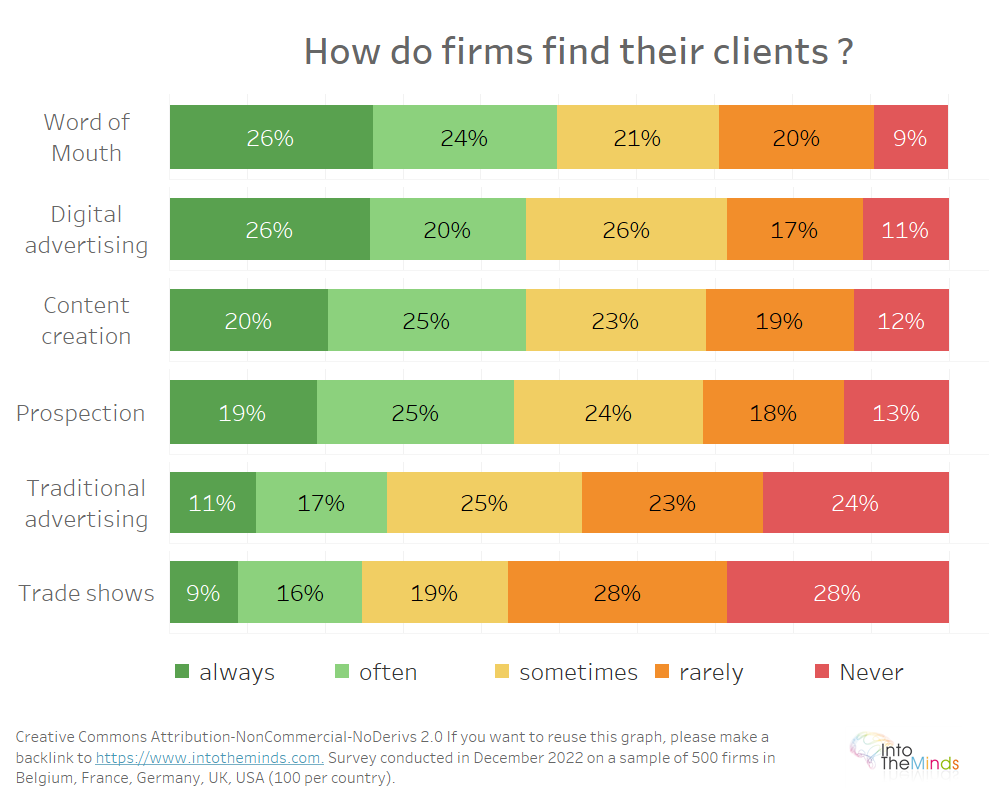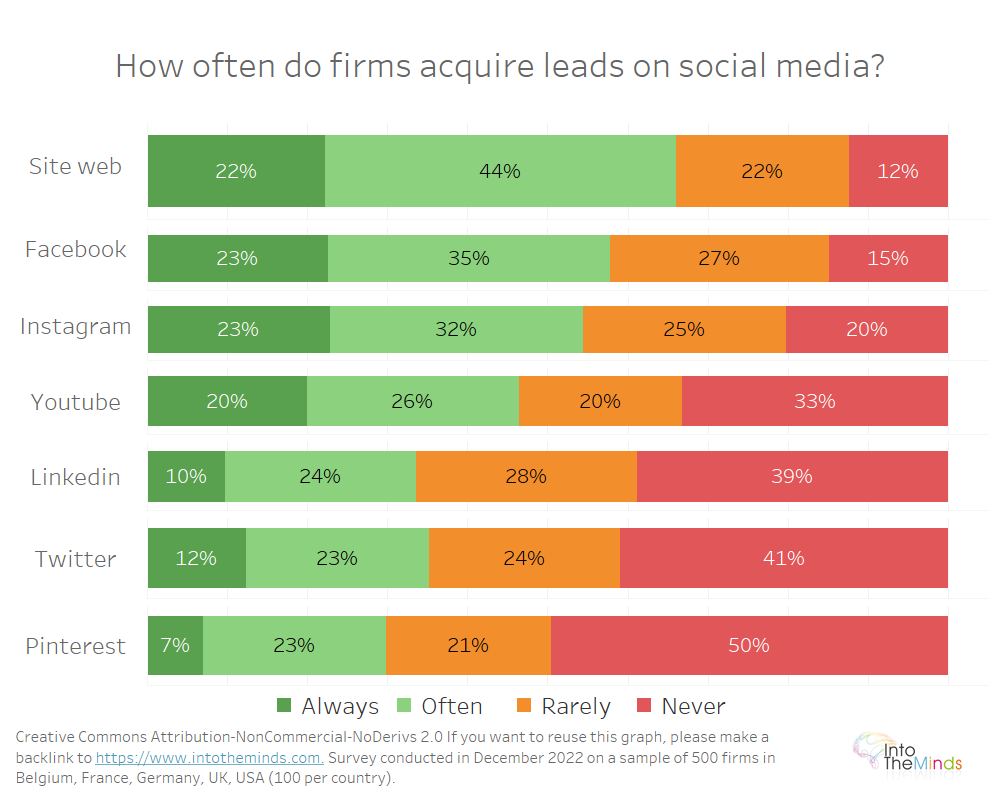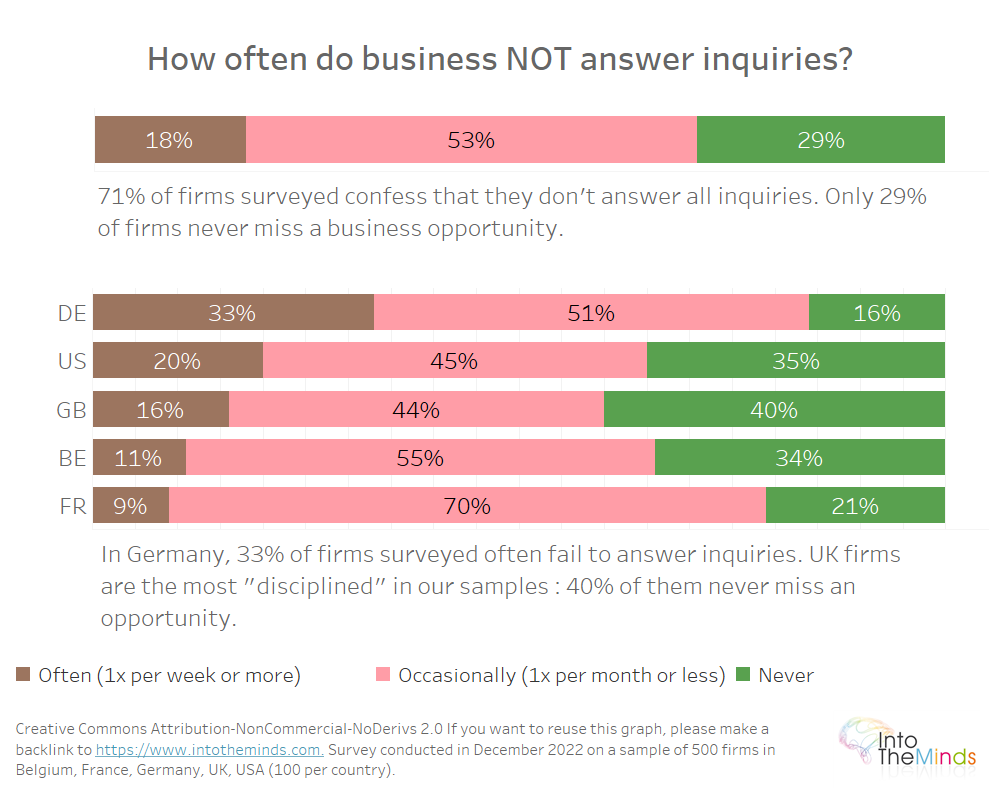Lead generation is one of the keys to business development. There are many ways to generate leads, and we wanted to understand what companies are doing in this area. We interviewed 500 managers in Europe and the US via a CAWI survey. Some of the results surprised us and even shocked us. We discovered that 71% of companies respond to only some of the requests they receive from prospects and that LinkedIn was not a lead generator for 67% of them.
Learn more about our survey solutions
In this article, we share our findings and thoughts on lead generation. Feel free to quote this article and reuse the graphics.
Lead generation: some statistics
- Only 29% of companies respond to all prospect requests
- 21% of companies admit to not responding to prospects at least once a week
- 50% of companies find customers frequently or very frequently through word of mouth
- 45% of companies say they find leads frequently or very frequently through content creation
- The website is the #1 lead generation channel: 66% of companies get leads frequently or always through this channel
1) How do companies find their customers?
First, we wanted to understand where the leads were coming from- the business opportunities that could turn into customers. We asked the 500 companies surveyed to rate the frequency of lead generation by channel.
Word of mouth, the number one lead generator
Word of mouth is the most important channel. 26% of respondents say they always find their leads via this channel. Only 9% of companies say they never receive leads via word-of-mouth. It is worth remembering that word-of-mouth is as much a result of customer satisfaction as customer loyalty.
Trade shows and traditional advertising are at the bottom of the ranking
This question also allows us to rank the lead generation channels among themselves. Trade shows come last and are followed by traditional advertising.
This result must be put into perspective because these two outbound marketing methods do not apply to all companies. Even if trade shows are abundant, the percentage of companies participating in them remains relatively low. Similarly, the percentage of companies that invest in traditional advertising is low.
So, there are probably explanations for the relevance of the lead generation channel.
Digital advertising, the queen of active prospecting
Among the “active” prospecting methods, digital advertising is the most popular. It is slightly ahead of traditional prospecting (cold calling, email) and content creation. 46% of the companies surveyed said they obtain leads frequently.
Content creation, #3 lead generation method
This last result surprised us a lot. This is obviously an encouraging result for those who believe in inbound marketing. We would not have imagined that companies would identify content creation as a lead generator. However, we will have to confirm this result with other surveys by increasing the sample size to reduce the error margin.
2) Lead generation and online channels
As we have seen in this article, there is still much work to be done in managing omnichannel. Local retailers, in particular, still need to pay more attention to online channels to make sales. The other key issue is the importance of online channels in lead acquisition.
We, therefore, wanted to understand what role online channels play in lead generation. We asked the 500 companies surveyed to rate the frequency of lead generation via their website and 6 social media. We used a subjective frequency scale to reflect the diversity of industries in the sample. The results are interesting and allow the following:
- objectify the use of social media in lead generation
- to classify the different channels according to their use
The website, the first lead generator
The results show, first of all, that some channels generate more leads than others. The website is logically in 1st place. Only 12% of the companies surveyed never get leads via this channel, compared to 66% who say they find leads frequently or very frequently.
At the other end of the spectrum is Pinterest. It is a fairly underground social network in terms of use by companies. 50% of the companies surveyed said they never get leads via this channel. This is probably due to the presence of the said companies on Pinterest.
LinkedIn is not perceived as a lead generation channel
Curiously, LinkedIn represents a frequent or very frequent lead acquisition channel for only 34% of the companies surveyed. This is surprising since many growth marketing advocates see LinkedIn as a relay for their automation techniques.
The reality seems different, but we need to understand the cause. Here are 3 questions that still need to be answered:
- Do companies perceive LinkedIn as a channel that can bring them leads?
- Are the results simply due to the lack of investment in using LinkedIn for business purposes?
- Or, are companies’ efforts on LinkedIn simply not paying off?
71% of companies surveyed miss out on business opportunities by simply not responding to their prospects.
3) A minority of companies respond to all incoming requests
The most important step to convert a lead into a customer is, of course, to respond to it. However, companies could be more disciplined in this matter.
71% of companies miss business opportunities
Our survey reveals that only 29% of companies respond to all incoming requests. In other words, 71% of companies surveyed are missing out on business opportunities by simply not responding to their prospects. How, in these conditions, can we hope to do business?
Of course, it would be necessary to go further in the analysis and distinguish between the B2B and B2C sectors of activity. Another survey will be necessary, but for now, let’s continue to dig into these results.
English and Americans are the most organized in converting leads
Since the respondents were evenly distributed among 5 countries, we can also analyze by country. However, the sample size requires some caution in interpreting the results.
The differences between countries are striking. British and American companies are the ones that declare to let commercial opportunities slip away the least. They are respectively 40% and 35% to respond to all incoming requests.
At the other end of the spectrum, 33% of the German companies in the sample confessed to not responding to prospects at least once a week.
At this stage, non-response to incoming requests is a reality, even though companies complain about the economic crisis. Another survey on a larger sample will have to confirm this result. Is there not a paradox here?
Or is this state of affairs due to operational constraints (lack of personnel, for example) that are symptomatic of other ills?
Methodology
An online survey was conducted among 500 companies by the market research firm IntoTheMinds between December 15 and 16, 2022. The 500 companies were divided equally between 5 countries: Germany, Belgium, the United States, France, and the United Kingdom.
Posted in Strategy.





